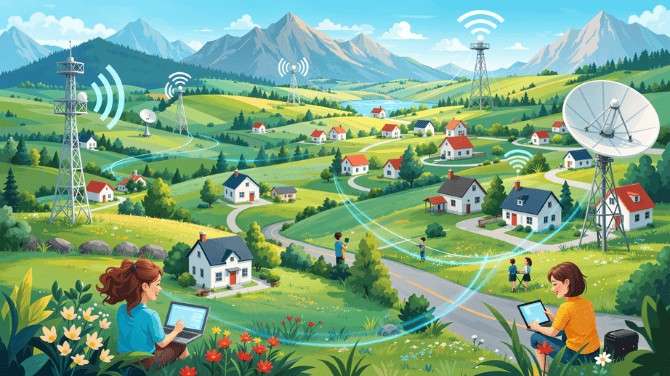


Discover top rural internet providers in the USA for 2026. Explore plans from Ubifi, Starlink, Viasat, and more to stay connected in remote areas.
Access to high-speed internet in rural areas has long been a challenge for residents, businesses, and travelers. Many remote locations still lack the infrastructure for traditional cable or fiber networks. This makes it hard to stay connected for work, education, or entertainment. As a result, rural users often depend on satellite, fixed wireless, or mobile broadband solutions to meet their connectivity needs.
Fortunately, advancements in 5G, 4G LTE, and satellite networks have significantly improved internet access in remote regions. In 2026, several providers offer fast, reliable, and flexible options designed for rural areas. This guide examines the top rural internet providers, outlines their plans and features, and explains how Ubifi stands out as a preferred choice for users looking for high-speed, low-latency, and hassle-free connectivity across the country.
Overview:
Ubifi has become a leading provider of rural internet in the USA. Using 5G and 4G LTE networks, Ubifi delivers fast and reliable internet to areas that often lack access from traditional broadband providers. Whether you live in a rural community or travel in an RV, Ubifi keeps you connected for work, entertainment, and communication.
Plans and Pricing:
Key Features:
Overview:
Starlink, a project by SpaceX, has gained attention for its low-earth orbit (LEO) satellite network. It brings high-speed internet to rural and remote areas worldwide.
Plans and Pricing:
Key Features:
Considerations:
Starlink has higher initial costs compared to many other rural internet providers due to equipment fees. While it offers extensive coverage, actual speeds can vary based on your location, weather, and network congestion.
Overview:
Viasat is a long-established satellite internet provider known for its rural coverage across the USA. It offers reliable services for homes, farms, and small businesses.
Plans and Pricing:
Key Features:
Considerations:
As with most satellite services, latency can be high, and speed may fluctuate due to weather or network congestion. Some plans also prioritize data during peak usage times.
Overview:
Rise Broadband offers fixed wireless internet solutions. It uses towers to provide broadband connectivity without needing cable or satellite dishes.
Plans and Pricing:
Key Features:
Considerations:
Rise Broadband’s service depends on a clear line-of-sight to towers, which might limit availability in certain hilly or forested areas.
Overview:
EarthLink provides 4G LTE wireless internet services designed to deliver consistent speeds to rural areas.
Plans and Pricing:
Key Features:
Considerations:
Speeds and performance can vary based on location and network conditions. EarthLink is suitable for users who value ease of setup and affordability.
Ubifi’s technology gives it an edge over traditional satellite providers. Unlike geostationary satellites that can cause high latency and slower speeds, Ubifi’s 5G/4G LTE service provides smoother performance, even in remote areas. It is recognized as one of the best satellite internet options for RV users. Their contract-free, unlimited plans offer flexibility and peace of mind. This makes Ubifi perfect for both permanent rural residents and traveling RV enthusiasts who need reliable, high-speed connectivity on the road.
Ubifi stands out for its contract-free, unlimited 5G/4G LTE plans. Starlink and Viasat are solid satellite options based on location and budget.
Starlink uses LEO satellites, offering lower latency and higher speeds than geostationary satellites. However, the equipment costs are higher.
Fixed wireless, like Rise Broadband, often offers more stable speeds and lower latency but is limited by tower coverage.
Yes. Ubifi’s portable 5G/4G LTE plans are ideal for RV users and travelers who need reliable internet on the go.
Ubifi offers unlimited data without throttling. Other providers like Viasat or EarthLink may have usage limits or speed restrictions after reaching a certain threshold.
Visit the provider’s website and enter your ZIP code. Availability and performance can vary greatly depending on where you live.
For rural residents and travelers in 2026, high-speed internet is now more accessible than ever. Ubifi leads the market with flexible, contract-free, unlimited 5G/4G LTE plans, making it perfect for remote homes and RV users. Other providers like Starlink, Viasat, Rise Broadband, and EarthLink offer strong alternatives depending on your location, budget, and usage needs. By comparing speed, availability, equipment costs, and plan flexibility, rural users can find the provider that ensures smooth streaming, reliable communication, and seamless work from anywhere. Staying connected in rural America has never been easier.
